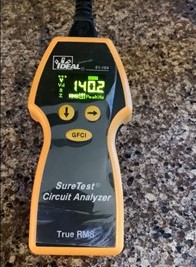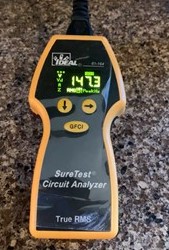What is a Lost Neutral?
A lost neutral occurs when the neutral wire of an electrical system becomes disconnected or damaged so that it can no longer carry current back to the transformer. The result of the lost neutral is that the two phases of the electrical system are now in series and being supplied by 240 volts.
Some of the loads on the system will be in series with each other, while others will be in parallel.
As a result of the lost neutral, some of these loads can have voltages that are significantly higher than 120. This high voltage can cause lights to blow out, and can damage other devices such as refrigerators, TVs, etc.
At the same time, other devices can have voltages much lower than the 120 volts that they need to operate properly.
NOTE: A lost neutral is NOT the same thing as a disconnected neutral on a branch circuit. A lost neutral is normally much more serious than a disconnected neutral which basically just prevents one or more receptacles and/or lights from working. See my post on disconnected neutrals here.
How Does a Lost Neutral Occur?
A lost neutral normally occurs outside the home. For a lost neutral situation to arise the neutral must be lost before the main electrical panel in the home.
By their nature, the cause of most lost neutrals is normally outside the home – somewhere between the utility pole and the service entrance into the home.
Some causes of lost neutrals are weather, animals, poor installation, corrosion. Anything that can cause the connection of the neutral wire to become damaged and incapable of carrying electrical current will result in a lost neutral.
I have heard of animals chewing through a neutral wire or connection.
Tree branches have pushed hard enough against the electrical line that it has broken the wire or caused it to become disconnected.
A poor electrical system installation can allow the neutral wire to become disconnected.
Damaged insulation and the resulting corrosion can cause the loss of the neutral.
As a home inspector, I have seen some electrical connections up near the weatherhead that are very corroded. If left uncorrected, this corrosion will eventually result in the connection being broken.
As I talk about causes of lost neutral, let me clarify one thing. It is just as possible for one of the two hot wires to be damaged as it is for the neutral to be damaged.
When a hot wire is lost, the home simply loses one phase of electricity so only half of the electrical devices in the home will work.
Since it is so obvious that half of everything in the home is no longer working, this condition is immediately recognized, and an electrician will normally be called to rectify the situation.
Also, while a lost hot phase is also a problem, it is not nearly as big a deal as losing the neutral because losing the neutral can destroy electrical/electronic equipment in the home.
Due to the seriousness of a lost neutral, I am focusing only on the neutral being lost in this post.
Properly Operating Electrical System
To further explain the concept of a lost neutral, let me start by showing you a diagram of a properly operating electric service.

Since each of the two phases utilizes the same neutral wire, all of the loads in the system are connected to this neutral, which in turn connects all of the loads together.
In a properly-functioning electrical system, it does not matter how many loads are running on each phase of the electrical system. They will all be supplied by 120 volts.
(For simplification, I will limit this explanation to 120-volt loads, and I will not discuss the two-phase loads that use 240 volts.)
One side of each load is connected to the “hot” side of the power system. Some are connected to one phase (+120 volts), while others are connected to the other phase (-120 volts).
The electrical current comes from the “hot” wire, goes through the load, and returns to the panel through the neutral wire.
All loads that are turned on will have 120 volts powering them – some from one phase and some from the other phase. As long as the electrical system is working like it is supposed to, every load on the system should go on working being powered by 120 volts.
As other things in the home such as lights, TVs, microwaves, washing machines, etc. are turned on and off, the power consumed in the home will change, but there will still be 120 volts powering each device.
Electrical System With a Lost Neutral
Now, let’s look at the situation where the neutral on a home’s electrical system is lost.
If a home loses its neutral, then a very dangerous and damaging situation will be the result. Let’s look at an example of this.
In the diagram below, the neutral wire has become disconnected or is otherwise damaged. You can see in the diagram that the neutral is no longer connected to the transformer, but it is still connected to all of the loads.
As you can see in the diagram below, all of these loads are still connected to each other through the neutral wire.
This remaining neutral wire serves to connect the two phases of the electrical system together in series with one another.
As a result, you now essentially have a 240-volt electrical system powering everything in the home.
Since voltages are just relative, I have re-labeled the voltages in the diagram. We now have one side labeled as 0 volts, while the other side is shown as 240 volts.

In order to show how much voltage each load is subjected to, we will first have to calculate the resistance of each load. We will do this by using a couple of fundamental electrical equations.
V=IR
V is voltage I is current in amps R is resistance in ohms
(NOTE: In the equation above, E is normally used as the symbol for volts, but I have used V to make it more clear)
P=VI
P is power in watts V is voltage I is current in amps
P=I2R
P is power in watts I is current in amps R is resistance in ohms
In the table below, I have shown the results of each calculation for each load.
(If you are interested in seeing how each number was calculated, the calculations are shown after the table.)
|
Load |
Item |
Watts |
Current (I=P/V) |
Resistance R=P/I2 |
| 1 | Light bulb | 60 watts | 0.5 amps | 240 ohms |
| 2 | Microwave | 1200 watts | 10 amps | 12 ohms |
| 3 | Big screen TV | 360 watts | 3 amps |
40 ohms |
P=VI or I=P/V I = 60/120 = 0.5 amps. Using the other equation P=I2R which can be rewritten as R=P/I2, we get the following result. R = 60 watts/(0.5)2 or 240 ohms.
Load 2 (1200-watt microwave) –
Using P=VI we get 1200 = 120 x I. Solving for I, we get 10 amps.
Now using the other equation we see that R = 1200/(10)2 or R = 12 ohms.
Load 3 (Big screen TV) –
Let’s assume that the TV uses 360 watts of power. Using the same equations, we get I = 3 amps. Solving for resistance, we get 40 ohms.
Let’s plug these numbers into the diagram.
(NOTE: The amps and watts shown above will change once the neutral is lost. The only reason we did the calculations above was to calculate the resistance of each load which will not change when the neutral is lost. You will see the importance of knowing the resistance momentarily.)

From the diagram below, we see that the two resultant loads are in series.
Now that we know the resistance on each half of the electrical system, we can calculate the voltage on each half.
The voltage that each load carries is proportional to its proportion of the total resistance of the combined loads.
Vupper = 240 (11.43/(11.43 + 40)) = 53.33 volts
Vlower = 240 (40/(11.43 + 40)) = 186.66 volts
Let’s look at this in the diagram.


On the other hand, there are almost 187 volts powering the big screen TV. 187 volts will probably fry the electronics in that TV fairly quickly.
Also, every time another load is turned on or turned off, the resultant resistance will change, and the voltages across the devices will change.
As an example, as additional loads on one phase are turned on, the overall resistance of the loads on that phase will decrease. This means that the voltage will also decrease on that phase.
Since the total voltage on the two phases is 240, as the voltage on one phase goes down, the voltage on the other phase will increase by the same amount.
Indications of a Lost Neutral –
Some indications of a lost neutral are the following:
- lights that are dimmer or brighter than normal;
- multiple lights that have burned out almost at the same time;
- lights that seem to dim or brighten noticeably when other loads in the home are turned on or off;
- Items that no longer operate for no obvious reason;
- electronics that seem to be running hotter or faster than normal;
- items that sound different than normal while they are running, etc.
A Real-Life Example of a Lost Neutral –
I got a phone call from a homeowner who said that the lights in his home dimmed significantly and stayed dim when his air conditioner kicked on. I told him that I would come out and take a look.
After he showed me what was going on, I took some voltage measurements.
Below are two photos that I took at a receptacle in the kitchen.
As you can see, the voltage was about 140 volts as measured at the receptacle. This was a very good indication of a lost neutral. I verified the lost neutral by turning on the garbage disposal while continuing to measure the voltage at the receptacle.
The second photo shows how the voltage increased by 7 volts simply by turning on the garbage disposal.


The homeowner ended up calling his electric company who came out and found some serious problems at the utility pole. This problem was actually affecting several nearby homes. After several hours of work, they finally got the problem fixed.
What to do if You Suspect a Lost Neutral
If you have one or more of these indications of a lost neutral, it would definitely be a good idea to do a little more follow-up.
If you have a multimeter, use it to check the voltage on a few receptacles. The voltage should be between about 110 and 125 volts. If the voltage is much different than this, then it is likely that you have a lost neutral on your home’s electrical system.
To verify a lost neutral, you can turn on another load while measuring the voltage of a receptacle, if the voltage changes by a few volts, then this is an almost-certain sign of a lost neutral.
If you have a lost neutral or suspect one, it would be wise to turn off or unplug everything in your home before they are ruined. Next call your electric company or an electrician to come find and fix the problem.
© 2021 Mike Morgan
This article was written by Mike Morgan, the owner of Morgan Inspection Services. Morgan Inspection Services has been providing home, septic and well inspection services throughout the central Texas area since 2002. He can be reached at 325-998-4663 or at mike@morganinspectionservices.com. No article, or portion thereof, may be reproduced or copied without prior written consent of Mike Morgan.

